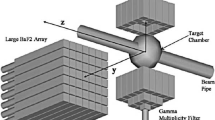Abstract
Nuclei embedded in a lattice are submitted to interactions with their surroundings. This produces a randomly fluctuating microfield at the nuclei, perturbing their energy levels. These perturbations can be considered as stochastic processes. Many of the fluctuating phenomena represent the result of a very large number of very small changes. The standard description of such fluctuations is a Gaussian process, defined as a process for which only the first and second moments are different from zero. If a radiating nucleus is constantly perturbed the radiated field can be regarded as undergoing phase fluctuations around the unperturbed nuclear Bohr frequency ω0. The instant frequency can then be written as ω(t)=ω0-x(t), where x(t) is the value of a stochastic variable X with zero mean. The first-order correlation function, whose Fourier transform gives the radiated frequency spectrum, depends on the probability function governing X. For a Gaussian, stationary, delta-correlated process, it is shown that the frequency spectrum is Lorentzian. For an arbitrary perturbation having a broad spectrum, it is shown that the frequency spectrum is again Lorentzian. For a narrow perturbation spectrum, the corresponding frequency spectrum is Gaussian.
Similar content being viewed by others
References
J. Odeurs, Phys. Rev. B52 (1995) 6166.
R. Coussement, G. S'heeren, M. Van Den Bergh and P. Boolchand, Phys. Rev. B 45 (1992) 755.
W. Wildner and U. Gonser, J. de Phys. (Paris) 40 (1979) C2–47.
G.R. Hoy and R.D. Taylor, J. Quant. Spectrosc. Radiat. Transfer 40 (1988) 763.
G.R. Hoy, S. Rezaie-Serej and R.D. Taylor, Hyp. Int. 58 (1990) 2513.
J.D. Cresser, Phys. Rep. 94 (1983) 47.
R. Loudon, The Quantum Theory of Light (Clarendon Press, Oxford, 1986).
N.G. Van Kampen, Stochastic Processes in Physics and Chemistry (North-Holland, Amsterdam, 1981).
B.W. Shore, The Theory of Coherent Atomic Excitation, Vol. 2 (Wiley, New York, 1990).
P. Meystre and M. Sargent III, Elements of Quantum Optics (Springer, New York, 1992).
D.S. Elliot, R. Roy and S.J. Smith, Phys. Rev. A26 (1982) 12.
Rights and permissions
About this article
Cite this article
Odeurs, J., Coussement, R. Models for homogeneous line broadening in long-livednuclear states. Hyperfine Interactions 107, 299–306 (1997). https://doi.org/10.1023/A:1012092714202
Issue Date:
DOI: https://doi.org/10.1023/A:1012092714202



